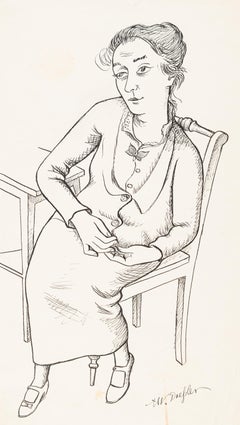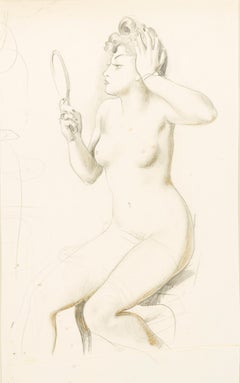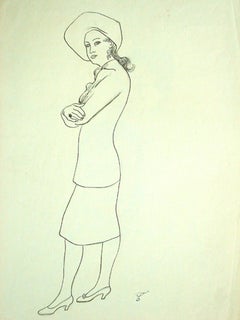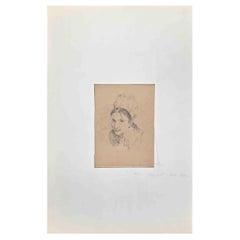August Wilhelm Dressler Art
German, 1886-1970
Wilhelm August Dressler is one of the painters of the New Objectivity (...) and was committed to social and political issues. The Berliner-of-choice defied stubbornly the summary classification. Dressler acted truthfully to his origin, temperament and insight as an individual who presents his bond as obligation, who takes his program as template and his slogan as abomination. Only few painters of his generation restrain so inconspicuously from the revolutionary storm and new trends that found its most effective expression in Expressionism of ” the Bridge” group and in the mystical works of the ‘Blue Rider’. Dressler’s self-imposed isolation is based neither on his capriciousness nor is it intentional – it is simply one of the inner necessities of his artistic existence.
One does not do justice to his work, if one tries to interpret only the visible facts, the artistic or the technical qualities in Dressler’s works. This painter lived his destiny with a stubbornly determined consequence of his fate: the pictures are nothing else than the graphic metaphors of the ‘introverted gaze’. He experienced grief and loneliness already during his youth. Dressler learns early about the shadow side of human existence – it becomes the basis of the way he perceived the world. ” I cannot separate myself from what has established me ” – there was a very immediate connection and solidarity between the painter and his personal experiences (l’art pour l’art attitude). Thus Dressler identifies himself with those embodiments of petty-bourgeois narrowness, with those disappointed and abandoned, with those who appreciate simple joys of life and those with quiet hopes. In his works the figurative language wins through its ability to depict and objectify feelings without words. Dressler does not paint to be modern or original. His way of perception is essential in a solid sense; he focuses on things, elements, and events that reflect a piece of life.
The closeness to the object and the attachment to the figure remain unchanged in Dressler’s oeuvre. One is tempted, looking at his works of five decades, to speak rather than about development but more of unfolding. The thematic inventory is from the beginning artist’s credo and basic motive: the form is added as the answer of the painter. It is Dressler’s personal preference not to correct reality nor to imitate it – his realism brings form and content, sensation and insight to life in a forceless manner.
Dressler feels, thinks and arguments his works on a more general level; his work is not an illustration of social misery or individual depravity. This “realist of the sharper tone” painterly transcends the limitations of genre and folklore; his “petty-bourgeois everyday life” is neither enclosed in the poor man’s pathos nor in the oh-human ecstasy. “Who controls the keyboard of nature”, proclaims Dressler, “can play in their own ways”.
Source: Delp’sche Verlagsbuchhandlung München, August Willhelm Dressler, Munich 1970.(Biography provided by Galerie Lehner)
to
16
1
6
13
3
6
6
2
2
Overall Height
to
Overall Width
to
15
13
12
8
5
5
5
4
2
2
2
1
1
1
1
1
1
1
1
1
1
16
1
4
1
16
6,863
3,204
2,516
1,217
10
7
5
4
4
Artist: August Wilhelm Dressler
Frau bei Tisch sitzend
By August Wilhelm Dressler
Located in Wien, 9
August Dressler is one of the painters of the New Objectivity. He is one of the lesser-known artists of the Weimar era, but he too, like his famous contemporaries Georg Grosz, John H...
Category
20th Century Modern August Wilhelm Dressler Art
Materials
Ink, Paper
Salzburger Berge
By August Wilhelm Dressler
Located in Wien, 9
August Dressler is one of the painters of the New Objectivity. He is one of the lesser-known artists of the Weimar era, but he too, like his famous contemporaries Georg Grosz, John H...
Category
1930s Modern August Wilhelm Dressler Art
Materials
Acrylic, Paper
Akt mit Strümpfen
By August Wilhelm Dressler
Located in Wien, 9
August Dressler is one of the painters of the New Objectivity. He is one of the lesser-known artists of the Weimar era, but he too, like his famous contemporaries Georg Grosz, John H...
Category
1920s Modern August Wilhelm Dressler Art
Materials
Watercolor, Ink
Akt mit Handspiegel
By August Wilhelm Dressler
Located in Wien, 9
August Dressler is one of the painters of the New Objectivity. He is one of the lesser-known artists of the Weimar era, but he too, like his famous contemporaries Georg Grosz, John H...
Category
20th Century Modern August Wilhelm Dressler Art
Materials
Pencil, Paper
Die Bildhauerin
By August Wilhelm Dressler
Located in Wien, 9
August Dressler is one of the painters of the New Objectivity. He is one of the lesser-known artists of the Weimar era, but he too, like his famous contemporaries Georg Grosz, John H...
Category
20th Century Modern August Wilhelm Dressler Art
Materials
Ink, Paper
Dame mit Hut
By August Wilhelm Dressler
Located in Wien, 9
August Dressler is one of the painters of the New Objectivity. He is one of the lesser-known artists of the Weimar era, but he too, like his famous contemporaries Georg Grosz, John H...
Category
20th Century Modern August Wilhelm Dressler Art
Materials
Pencil, Paper
Stilllife
By August Wilhelm Dressler
Located in Wien, 9
August Dressler is one of the painters of the New Objectivity. He is one of the lesser-known artists of the Weimar era, but he too, like his famous contemporaries Georg Grosz, John H...
Category
20th Century Modern August Wilhelm Dressler Art
Materials
Oil, Paint, Canvas
Frau mit blauem Kleid
By August Wilhelm Dressler
Located in Wien, 9
August Dressler is one of the painters of the New Objectivity. He is one of the lesser-known artists of the Weimar era, but he too, like his famous contemporaries Georg Grosz, John H...
Category
20th Century Modern August Wilhelm Dressler Art
Materials
Watercolor, Paper
Stehender Akt / Standing Nude
By August Wilhelm Dressler
Located in Wien, 9
August Dressler is one of the painters of the New Objectivity. He is one of the lesser-known artists of the Weimar era, but he too, like his famous contemporaries Georg Grosz, John H...
Category
20th Century Modern August Wilhelm Dressler Art
Materials
Paper, Graphite
Landschaft bei Naunhof
By August Wilhelm Dressler
Located in Wien, 9
August Dressler is one of the painters of the New Objectivity. He is one of the lesser-known artists of the Weimar era, but he too, like his famous contemporaries Georg Grosz, John H...
Category
20th Century Modern August Wilhelm Dressler Art
Materials
Paint, Oil, Canvas
Säugling / Infant
By August Wilhelm Dressler
Located in Wien, 9
August Dressler is one of the painters of the New Objectivity. He is one of the lesser-known artists of the Weimar era, but he too, like his famous contemporaries Georg Grosz, John H...
Category
20th Century Modern August Wilhelm Dressler Art
Materials
Canvas, Paint, Oil
Angel Bride
By August Wilhelm Dressler
Located in Wien, 9
August Dressler is one of the painters of the New Objectivity. He is one of the lesser-known artists of the Weimar era, but he too, like his famous contemporaries Georg Grosz, John H...
Category
20th Century Modern August Wilhelm Dressler Art
Materials
Glass, Paint
Florentine Woman
By August Wilhelm Dressler
Located in Wien, 9
August Dressler is one of the painters of the New Objectivity. He is one of the lesser-known artists of the Weimar era, but he too, like his famous contemporaries Georg Grosz, John H...
Category
1930s Modern August Wilhelm Dressler Art
Materials
Oil, Panel
Man with pipe
By August Wilhelm Dressler
Located in Wien, 9
August Dressler is one of the painters of the New Objectivity. He is one of the lesser-known artists of the Weimar era, but he too, like his famous contemporaries Georg Grosz, John H...
Category
1930s Modern August Wilhelm Dressler Art
Materials
Ink, Watercolor
Behind the Curtain
By August Wilhelm Dressler
Located in Wien, 9
August Wilhelm Dressler, Behind the Curtain, 1940, Oil on Wood Panel, 60 x 50 cm.
Signed lower left.
Category
1940s Modern August Wilhelm Dressler Art
Materials
Wood Panel, Oil
August Wilhelm Dressler Drawing "Young Woman Seated in an Armchair", 1933
By August Wilhelm Dressler
Located in Berlin, DE
Pencil on paper, 1933 by August Wilhelm Dressler ( 1886-1970 ). Signed lower left in pencil: AW. Dressler
Dated lower right in pencil: 1933. Sheet dimensions: 16.54 x 11.61 in ( 42 x...
Category
1930s August Wilhelm Dressler Art
Materials
Pencil
Related Items
Portrait of Woman - Original Pencil Drawing by Henri Regnault - 1861
Located in Roma, IT
Portrait of Woman is an original pencil drawing realized by Henri Regnault (1843-1871) in 1861.
Good condition, except for some torn and missing paper ...
Category
1860s Modern August Wilhelm Dressler Art
Materials
Pencil, Paper
No Reserve
H 8.27 in W 5.91 in D 0.08 in
'Fremantle Harbor, Perth, Western Australia', Post Impressionist, SFAA, MoMA
By Byron Randall
Located in Santa Cruz, CA
Signed lower left, 'Byron' for Byron Randall (American, 1918-1999) and dated 1947.
Born in Tacoma, WA on Oct. 23, 1918. Randall was in Salem, OR during the 1930s. He created artwork...
Category
1940s Modern August Wilhelm Dressler Art
Materials
Acrylic, Paper, Gouache
Le Croates - Original Drawing By Herbert Knotel - 1940s
Located in Roma, IT
Le Croates is an original drawing in ink and watercolor realized by Herbert Knotel in 1930/40s.
Good condition except for being aged.
The artwork is depicted through strong lines i...
Category
1940s Modern August Wilhelm Dressler Art
Materials
Watercolor, Ink
No Reserve
H 10.24 in W 6.3 in D 0.08 in
1940s Charcoal and Pencil Portrait of a Man
Located in Arp, TX
Artist Unknown
"Tie and Glasses"
c. 1940s
Charcoal and pencil on paper
13.5"x17" image 15.5"x19" paper unframed $250
Unsigned
*Listed price reflects custom framing selected by seller...
Category
1940s Modern August Wilhelm Dressler Art
Materials
Paper, Charcoal, Carbon Pencil
Profiles - Drawing by Alberto Ziveri - 1930s
By Alberto Ziveri
Located in Roma, IT
Profiles is a drawing realized by Alberto Ziveri in the 1930s.
Pencil on paper.
Hand-signed.
In good conditions with some foxing.
Category
20th Century Modern August Wilhelm Dressler Art
Materials
Pencil, Paper
"Elie", Trees Inhabited by Human in Nature, Pigments Ink Drawing on Paper
By Frank Girard
Located in Clermont-Ferrand, Auvergne-Rhône-Alpes
This drawing by Frank Girard is created with pigments, Chinese ink, watercolors, acrylic, and colored pencils on 300g/m2 neutral white paper. It is not framed.
Through drawings, the...
Category
2010s Realist August Wilhelm Dressler Art
Materials
Paper, Ink, Acrylic, Watercolor, Color Pencil, Pigment
H 17.05 in W 11.42 in D 0.02 in
Boston Abstract Expressionist Hyman Bloom Original Pencil Drawing Martin Sumers
By Hyman Bloom
Located in Surfside, FL
This is a unique artwork. This is an original Hyman Bloom drawing of fellow artist and his very good friend Martin Sumers.I believe this was drawn at the “variations of a theme” at Sumers gallery in NYC. The last two photos show a poster and a card from their shows. it is not included in this listing, it is just for provenance.
Provenance: Acquired from the Sumers estate collection.
Hyman Bloom (March 29, 1913 – August 26, 2009) was a Latvian-born American painter. His work was influenced by his Jewish heritage and Eastern religions as well as by artists including Altdorfer, Grünewald, Caravaggio, Rembrandt, Blake, Bresdin, James Ensor and Chaim Soutine. He first came to prominence when his work was included in the 1942 Museum of Modern Art exhibition "Americans 1942 -- 18 Artists from 9 States". MoMA purchased 2 paintings from the exhibition and Time magazine singled him out as a "striking discovery" in their exhibition review.
His work was selected for both the 1948 and 1950 Venice Biennale exhibitions and his 1954 retrospective traveled from Boston's Institute of Contemporary Art to the Albright Gallery and the de Young Museum before closing out at The Whitney Museum of American Art in 1955. In a 1954 interview with Yale art professor Bernard Chaet, Willem de Kooning indicated that he and Jackson Pollock both considered Bloom to be “America’s first abstract expressionist”, a label that Bloom would disavow. Starting in the mid 1950s his work began to shift more towards works on paper and he exclusively focused on drawing throughout the 1960s, returning to painting in 1971. He continued both drawing and painting until his death in 2009 at the age of 9
Hyman Bloom (né Melamed) was born into an orthodox Jewish family in the tiny Jewish village of Brunavišķi in what is now Latvia, then part of the Russian Empire
At a young age Bloom planned to become a rabbi, but his family could not find a suitable teacher. In the eighth grade he received a scholarship to a program for gifted high school students at the Museum of Fine Arts. He attended the Boston High School of Commerce, which was near the museum. He also took art classes at the West End Community Center, a settlement house. The classes were taught by Harold Zimmerman, a student at the School of the Museum of Fine Arts, who also taught the young Jack Levine at another settlement house in Roxbury. When Bloom was fifteen, he and Levine began studying with a well-known Harvard art professor, Denman Ross, who rented a studio for the purpose and paid the boys a weekly stipend to enable them to continue their studies rather than take jobs to support their families.
He took Bloom and Levine on a field trip to the Museum of Modern Art in New York, where Bloom was impressed by the work of Rouault and Soutine and began experimenting with their expressive painting styles.
In the 1930s Bloom worked sporadically for the Public Works of Art Project and the Federal Art Project (WPA), He shared a studio in the South End with Levine and another artist, Betty Chase. It was during this period that he developed a lifelong interest in Eastern philosophy and music, and in Theosophy.
He first received national attention in 1942 when thirteen of his paintings were included in the Museum of Modern Art (MoMA) exhibition Americans 1942: 18 Artists from 9 States, curated by Dorothy Miller. MoMA purchased two of his paintings from that exhibition, and he was featured in Time magazine. The titles of his paintings in the exhibition reflect some of his recurring themes. Two were titled The Synagogue, another, Jew with the Torah; Bloom was actually criticized by one reviewer for including "stereotypical" Jewish images. He also had two paintings titled The Christmas Tree, and another titled The Chandelier, both subjects he returned to repeatedly. Another, Skeleton (c. 1936), was followed by a series of cadaver paintings in the forties, and The Fish (c. 1936) was one of many paintings and drawings of fish he created over the course of his career.
Bloom was associated at first with the growing Abstract Expressionist movement. Willem de Kooning and Jackson Pollock, who first saw Bloom's work at the MoMA exhibition, considered Bloom "the first Abstract Expressionist artist in America." In 1950 he was chosen, along with the likes of de Kooning, Pollock, and Arshile Gorky, to represent the United States at the Venice Biennale. That same year Elaine de Kooning wrote about Bloom in ARTnews, noting that in paintings such as The Harpies, his work approached total abstraction: "the whole impact is carried in the boiling action of the pigment". In 1951 Thomas B. Hess reproduced Bloom's Archaeological Treasure in his first book, Abstract Painting: Background and American Phase, along with works by Picasso, Pollock, and others. Both de Kooning and Hess remarked on Bloom's expressive paint handling, a key characteristic of Abstract Expressionist painting.
As abstract expressionism dominated the American art world, Bloom became disenchanted with it, calling it "emotional catharsis, with no intellectual basis." In addition, instead of moving to New York to pursue his career, he opted to stay in Boston. As a result he fell out of favor with critics and never achieved the kind of fame that Pollock and others did. He disliked self-promotion and never placed much value on critical acclaim.
Many of Bloom's paintings feature rabbis, usually holding the Torah. According to Bloom, his intentions were more artistic than religious. He began questioning his Jewish faith early in life, and painted rabbis, he claimed, because that was what he knew. Over the course of his career he produced dozens of paintings of rabbis...
Category
20th Century Modern August Wilhelm Dressler Art
Materials
Paper, Pencil
Black and White Abstract Figurative Drawing of Men with Text Elements
Located in Houston, TX
Monochromatic abstract figurative drawing by Texas artist Ike E. Morgan. The drawing depicts two figures in profile and some textual elements around them. Signed by the artist at the...
Category
1990s American Modern August Wilhelm Dressler Art
Materials
Pencil, Archival Paper
H 18.43 in W 22.75 in D 2.75 in
"Persepective", Pigments Watercolor Acrylic Paper Drawing
By Frank Girard
Located in Clermont-Ferrand, Auvergne-Rhône-Alpes
Titled "Perspective", this artwork created by Frank Girard, utilizes pigments, Chinese ink, watercolors, acrylics, and colored pencils on 400g/m2 neutral white paper. It remains unfr...
Category
2010s Realist August Wilhelm Dressler Art
Materials
Paper, Ink, Acrylic, Watercolor, Color Pencil, Pigment
H 13.39 in W 17.33 in D 0.02 in
7e Hussards - Drawing By Herbert Knotel - 1940s
Located in Roma, IT
7e Hussards is an original drawing in ink and watercolor realized by Herbert Knotel in 1930/40s.
Good condition except for being aged.
Hand-signed.
T...
Category
1940s Modern August Wilhelm Dressler Art
Materials
Watercolor, Ink
French Modern Drawing by Jean Hélion - Veil Homme
By Jean Hélion
Located in Paris, IDF
Veil Homme
1947
drawing
26,9 x 21 cm
Registered on the catalogue raisonné with inventory number : N°0252 cat. B
sold without frame
about Jean Hélion (April 21, 1904 – October 27, 19...
Category
1960s Modern August Wilhelm Dressler Art
Materials
Pencil, Paper
Portrait of a Young Woman - 1900s - René François Xavier Prinet - Drawing
By René Francois Xavier Prinet
Located in Roma, IT
Portrait of A Young Woman is an original artwork realized by the French artist and illustrator René François Xavier Prinet between the end of the XIX and the beginning of the XX cent...
Category
Early 1900s Modern August Wilhelm Dressler Art
Materials
Paper, Pencil
René Francois Xavier PrinetPortrait of a Young Woman - 1900s - René François Xavier Prinet - Drawing
H 12.6 in W 9.45 in D 0.08 in
August Wilhelm Dressler art for sale on 1stDibs.
Find a wide variety of authentic August Wilhelm Dressler art available for sale on 1stDibs. You can also browse by medium to find art by August Wilhelm Dressler in paint, paper, oil paint and more. Much of the original work by this artist or collective was created during the 20th century and is mostly associated with the modern style. Not every interior allows for large August Wilhelm Dressler art, so small editions measuring 11 inches across are available. Customers who are interested in this artist might also find the work of Louise Laplante, Georges Gobo, and Eugène Giraud. August Wilhelm Dressler art prices can differ depending upon medium, time period and other attributes. On 1stDibs, the price for these items starts at $701 and tops out at $15,752, while the average work can sell for $2,363.







